Here's a list of basic equipment for extract brewing of 5gal batches that I think is a good start, from my limited experience.
Some of these can only be found in home brew stores, some in any hardware store like Lowes or HomeDepot. Craigslist is also a good source to find used stuff for great deals, so I would give it a try.
1) Aluminum or Stainless Steel pot, minimum of 6gal or 24Qt. Ideal would be 32Qt or 40Qt. Stainless Steel is much more expensive but easier to clean. Aluminum is also fine, so choose whatever meet you budget. Those turkey deep frying sets are great and comes with the cooker also.
Aluminum or Stainless Steel pot, minimum of 6gal or 24Qt. Ideal would be 32Qt or 40Qt. Stainless Steel is much more expensive but easier to clean. Aluminum is also fine, so choose whatever meet you budget. Those turkey deep frying sets are great and comes with the cooker also.
2) Propane outdoor burner. Again, the setup for turkey deep frying would do it all. You can also use your stove top but some are not powerful enough. Those electric with a flat ceramic top are quite powerful and would mostly be fine. Remember, you will need to bring about 5gals of water to a full boil, so you will need as much heat power as possible. If willing to buy a propane burner, the "Bayou Classic’s Kick A Propane Burner" is awesome and about $75 and has plenty of power, about 200,000 BTU's!
Propane outdoor burner. Again, the setup for turkey deep frying would do it all. You can also use your stove top but some are not powerful enough. Those electric with a flat ceramic top are quite powerful and would mostly be fine. Remember, you will need to bring about 5gals of water to a full boil, so you will need as much heat power as possible. If willing to buy a propane burner, the "Bayou Classic’s Kick A Propane Burner" is awesome and about $75 and has plenty of power, about 200,000 BTU's!
3) Wort chiller. This will be used to cool the work after boil. You can build it yourself or buy one from you local LHBS(local home brew store). If you prefer to build one, a 3/8" ID by 30 to 50ft long copper coil works just fine. You will also need to get two pieces of 3/8" ID by 5ft long hose to attached to the coil. I recommend to use stainless steel clamps to secure the hoses to the coil. You will need one adapter 3/8" barb to Garden Hose in order to connect the water to the chiller. If using the faucet in
Wort chiller. This will be used to cool the work after boil. You can build it yourself or buy one from you local LHBS(local home brew store). If you prefer to build one, a 3/8" ID by 30 to 50ft long copper coil works just fine. You will also need to get two pieces of 3/8" ID by 5ft long hose to attached to the coil. I recommend to use stainless steel clamps to secure the hoses to the coil. You will need one adapter 3/8" barb to Garden Hose in order to connect the water to the chiller. If using the faucet in
your kitchen, get one adapter to adapt the kitchen faucets to garden hose type threads.
4) Hydrometer. This will be used to measure the quantity of sugars in your wort and during fermentation. As the yeast works the sugars into CO2 and Alcohol during fermentation, the sugar levels drops and by measuring that we can identify when the fermentation is completed and the alcohol potential of a given wort.
Hydrometer. This will be used to measure the quantity of sugars in your wort and during fermentation. As the yeast works the sugars into CO2 and Alcohol during fermentation, the sugar levels drops and by measuring that we can identify when the fermentation is completed and the alcohol potential of a given wort.
5)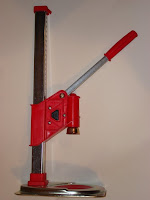 Bottle caper. If using regular bottles, a table bottle caper as seen here is the best option. Some other types are available on LHBS but are not as stable and easy to use than this one. Regular 12 or 22oz bottles can be bought on LHBS, or used beer bottles (not the screw in types) can also be re-used. Other option for bottling are plastic pet types and flip-top bottles, also good choices.
Bottle caper. If using regular bottles, a table bottle caper as seen here is the best option. Some other types are available on LHBS but are not as stable and easy to use than this one. Regular 12 or 22oz bottles can be bought on LHBS, or used beer bottles (not the screw in types) can also be re-used. Other option for bottling are plastic pet types and flip-top bottles, also good choices.
6)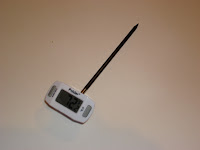 Thermometer. A good thermometer is required for home brewing. I will be use to make sure your wort was cooled enough to pitch the yeast and later, if moving to All grain process, even more important. I recommend any digital kitchen thermometer, like the photo here. These cost under $20 and are very precised and easy to use. Dial type thermometers are also used for home brewing. In any case, a calibration test is recommended to make sure it is accurate enough. That can be done by testing it on 32F(freezing point) water and 212F (water boiling point).
Thermometer. A good thermometer is required for home brewing. I will be use to make sure your wort was cooled enough to pitch the yeast and later, if moving to All grain process, even more important. I recommend any digital kitchen thermometer, like the photo here. These cost under $20 and are very precised and easy to use. Dial type thermometers are also used for home brewing. In any case, a calibration test is recommended to make sure it is accurate enough. That can be done by testing it on 32F(freezing point) water and 212F (water boiling point).
7)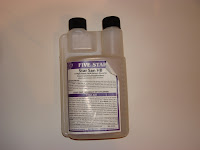 Sanitizing solution. This a must and I recommend Star-san. All equipment that will be in contact with the beer after the wort was chilled, needs to be sanitized to prevent contamination than can ruin a beer batch. Usually those equipments are let soaking for few minutes.
Sanitizing solution. This a must and I recommend Star-san. All equipment that will be in contact with the beer after the wort was chilled, needs to be sanitized to prevent contamination than can ruin a beer batch. Usually those equipments are let soaking for few minutes.
8)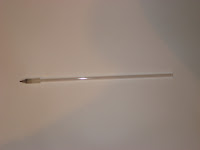 Bottle filler - This is used to fill the bottles from down up so the beer does not aerate and avoid oxidation, what can result in shorter shelf life and changes in taste.
Bottle filler - This is used to fill the bottles from down up so the beer does not aerate and avoid oxidation, what can result in shorter shelf life and changes in taste.
9) Bottle washer - This is attached to a faucet and is a valve that releases a nice water jet up inside the bottle as you press the bottle down against it and is the easiest way to clean your bottles before sanitizing then for filling. It will attached to the same adapter mentioned on the wort chiller.
Bottle washer - This is attached to a faucet and is a valve that releases a nice water jet up inside the bottle as you press the bottle down against it and is the easiest way to clean your bottles before sanitizing then for filling. It will attached to the same adapter mentioned on the wort chiller.
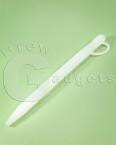
 12) Other - These include a big funnel, a strainer, a long spoon, bottle caps, a 5gal plastic container to hold the sanitizing solution, hoses for transferring beer and wort, a beer thief with will help to get samples for gravity test and a adhesive thermometer that you will stick to the fermenter to keep track of the fermentation temperatures.
12) Other - These include a big funnel, a strainer, a long spoon, bottle caps, a 5gal plastic container to hold the sanitizing solution, hoses for transferring beer and wort, a beer thief with will help to get samples for gravity test and a adhesive thermometer that you will stick to the fermenter to keep track of the fermentation temperatures.
Some of these can only be found in home brew stores, some in any hardware store like Lowes or HomeDepot. Craigslist is also a good source to find used stuff for great deals, so I would give it a try.
1)
2)
 Propane outdoor burner. Again, the setup for turkey deep frying would do it all. You can also use your stove top but some are not powerful enough. Those electric with a flat ceramic top are quite powerful and would mostly be fine. Remember, you will need to bring about 5gals of water to a full boil, so you will need as much heat power as possible. If willing to buy a propane burner, the "Bayou Classic’s Kick A Propane Burner" is awesome and about $75 and has plenty of power, about 200,000 BTU's!
Propane outdoor burner. Again, the setup for turkey deep frying would do it all. You can also use your stove top but some are not powerful enough. Those electric with a flat ceramic top are quite powerful and would mostly be fine. Remember, you will need to bring about 5gals of water to a full boil, so you will need as much heat power as possible. If willing to buy a propane burner, the "Bayou Classic’s Kick A Propane Burner" is awesome and about $75 and has plenty of power, about 200,000 BTU's!3)
 Wort chiller. This will be used to cool the work after boil. You can build it yourself or buy one from you local LHBS(local home brew store). If you prefer to build one, a 3/8" ID by 30 to 50ft long copper coil works just fine. You will also need to get two pieces of 3/8" ID by 5ft long hose to attached to the coil. I recommend to use stainless steel clamps to secure the hoses to the coil. You will need one adapter 3/8" barb to Garden Hose in order to connect the water to the chiller. If using the faucet in
Wort chiller. This will be used to cool the work after boil. You can build it yourself or buy one from you local LHBS(local home brew store). If you prefer to build one, a 3/8" ID by 30 to 50ft long copper coil works just fine. You will also need to get two pieces of 3/8" ID by 5ft long hose to attached to the coil. I recommend to use stainless steel clamps to secure the hoses to the coil. You will need one adapter 3/8" barb to Garden Hose in order to connect the water to the chiller. If using the faucet inyour kitchen, get one adapter to adapt the kitchen faucets to garden hose type threads.
4)
5)
6)
7)
8)
9)
10)  Fermenter stopper and airlock- It will close the fermenter and provide an isolation , allowing the CO2 generated during fermentation to scape but blocking the external air to contaminate the wort.
Fermenter stopper and airlock- It will close the fermenter and provide an isolation , allowing the CO2 generated during fermentation to scape but blocking the external air to contaminate the wort.
11) Carboy - Usually two are required. One will be used as your fermenter and the other as a temporary reservoir to be used to prime the beer once fermentation is completed, then used to fill the bottles or kegs. I recommend this one from better bottle, 6gal size. Glass carboys are also found but are not as safe as these. These food grade plastic carboys can be drilled so spigots can be attached to provide easy access to the beer either for testing the sugar levels or to transfer to the priming/bottling carboy.
Carboy - Usually two are required. One will be used as your fermenter and the other as a temporary reservoir to be used to prime the beer once fermentation is completed, then used to fill the bottles or kegs. I recommend this one from better bottle, 6gal size. Glass carboys are also found but are not as safe as these. These food grade plastic carboys can be drilled so spigots can be attached to provide easy access to the beer either for testing the sugar levels or to transfer to the priming/bottling carboy.
 Carboy - Usually two are required. One will be used as your fermenter and the other as a temporary reservoir to be used to prime the beer once fermentation is completed, then used to fill the bottles or kegs. I recommend this one from better bottle, 6gal size. Glass carboys are also found but are not as safe as these. These food grade plastic carboys can be drilled so spigots can be attached to provide easy access to the beer either for testing the sugar levels or to transfer to the priming/bottling carboy.
Carboy - Usually two are required. One will be used as your fermenter and the other as a temporary reservoir to be used to prime the beer once fermentation is completed, then used to fill the bottles or kegs. I recommend this one from better bottle, 6gal size. Glass carboys are also found but are not as safe as these. These food grade plastic carboys can be drilled so spigots can be attached to provide easy access to the beer either for testing the sugar levels or to transfer to the priming/bottling carboy. 
 12) Other - These include a big funnel, a strainer, a long spoon, bottle caps, a 5gal plastic container to hold the sanitizing solution, hoses for transferring beer and wort, a beer thief with will help to get samples for gravity test and a adhesive thermometer that you will stick to the fermenter to keep track of the fermentation temperatures.
12) Other - These include a big funnel, a strainer, a long spoon, bottle caps, a 5gal plastic container to hold the sanitizing solution, hoses for transferring beer and wort, a beer thief with will help to get samples for gravity test and a adhesive thermometer that you will stick to the fermenter to keep track of the fermentation temperatures.This list is what I can remember right now and is based on my personal experience. Some brewers have different preferences and that's ok. The more feedback you get before starting and buying your equipment the better. Do a lot of research on the web, visit your local LHBS, home brew clubs and on-line home brewing forums to make sure you will be spending your buck wisely.
No comments:
Post a Comment